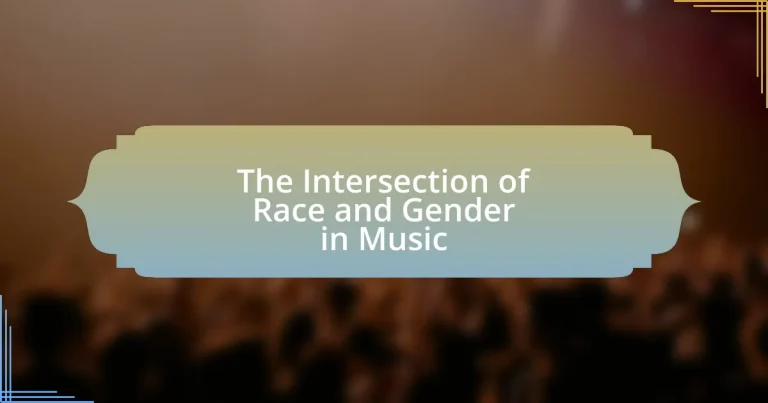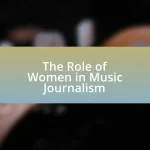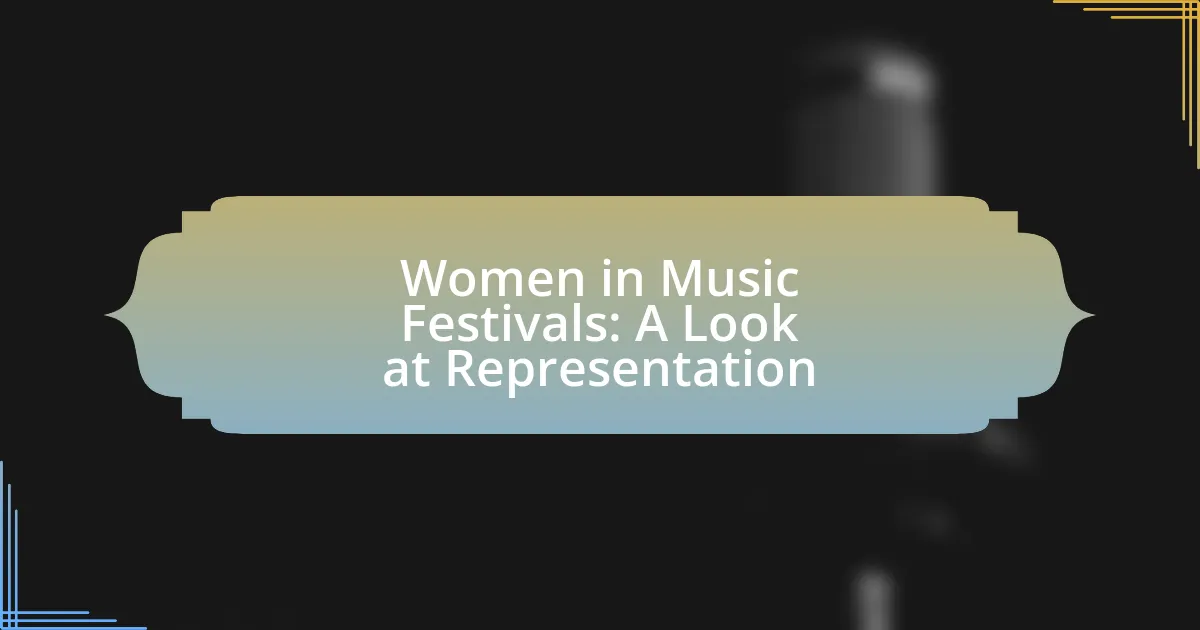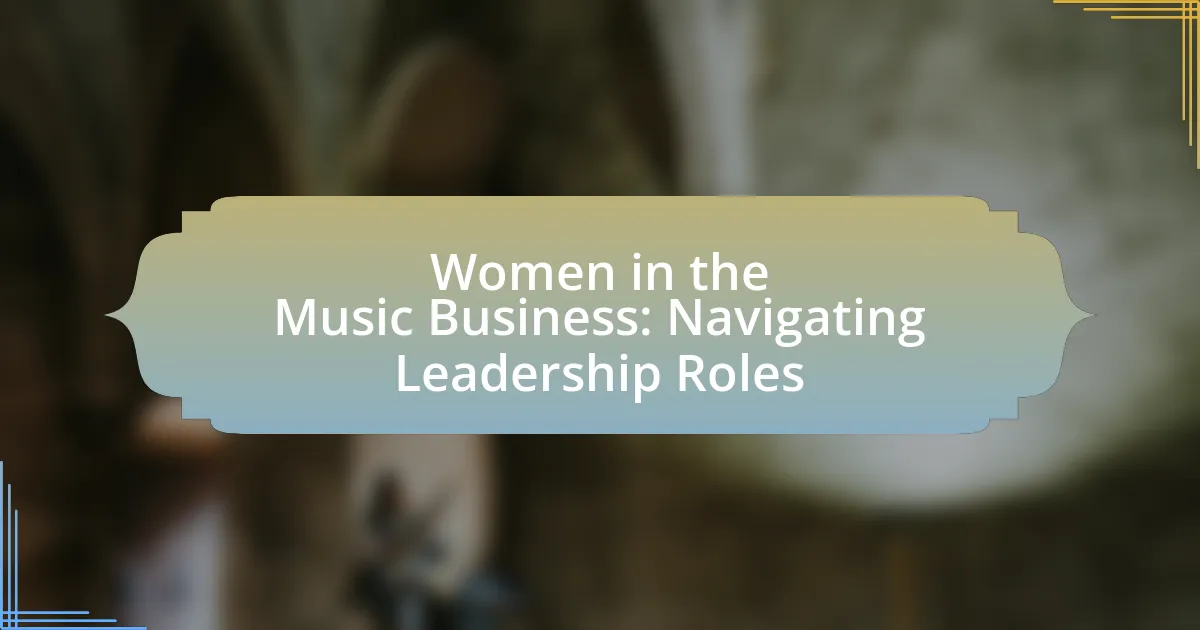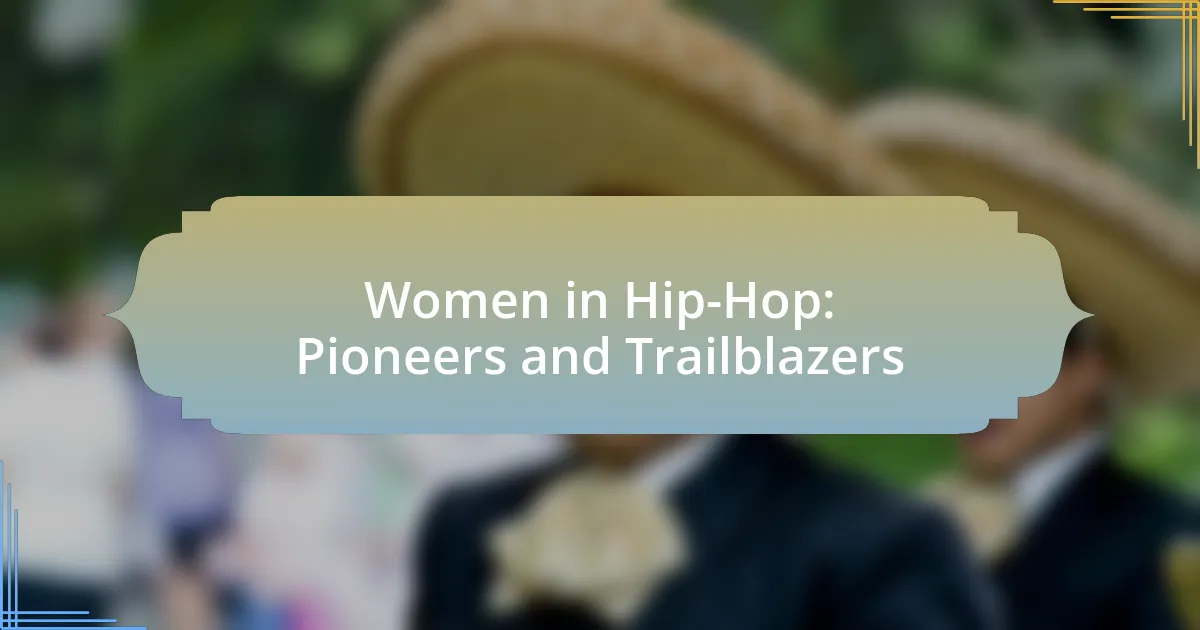The intersection of race and gender in music examines how these social categories shape musical expression, representation, and industry dynamics. Historically, women of color have faced unique challenges, often being marginalized in genres dominated by white male artists. This article explores the influence of race and gender on musical genres, the historical contexts that have shaped these dynamics, and the importance of studying this intersection for understanding contemporary issues in the music industry. Key themes include representation, empowerment, and social critique, highlighting the contributions of women of color and the ongoing challenges they face in achieving equity within the music landscape.
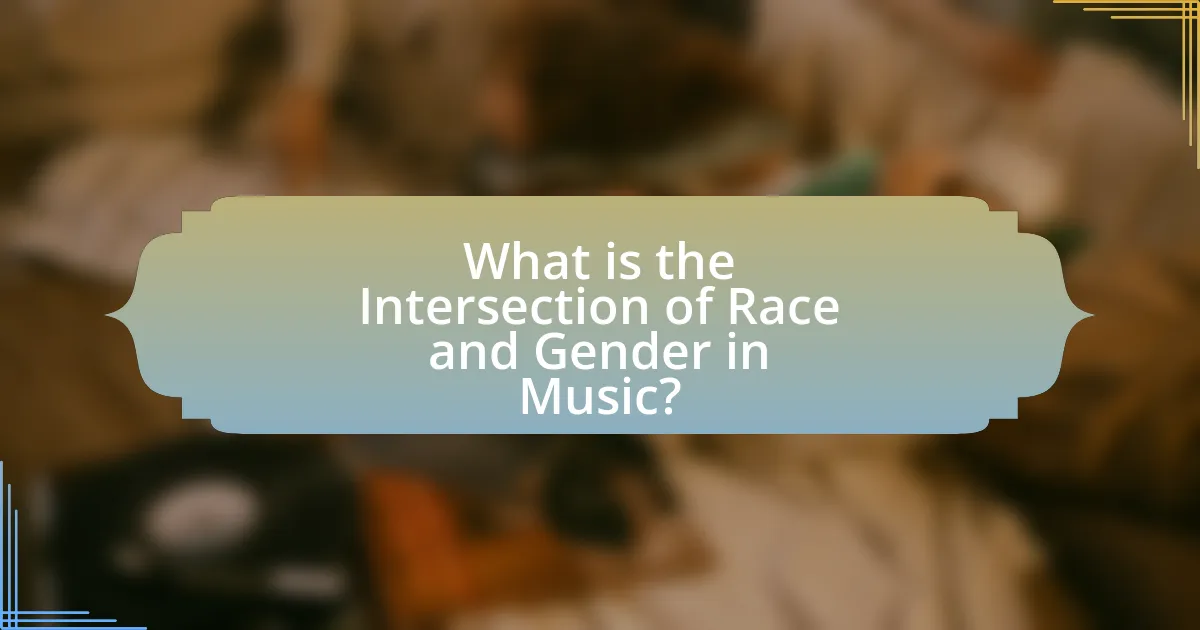
What is the Intersection of Race and Gender in Music?
The intersection of race and gender in music refers to the ways in which these two social categories influence and shape musical expression, representation, and industry dynamics. Historically, women of color have faced unique challenges and barriers in the music industry, often being marginalized in genres dominated by white male artists. For instance, Black women in music, such as Billie Holiday and Aretha Franklin, have used their platforms to address issues of racial and gender inequality, highlighting the dual impact of their identities. Research indicates that women of color are underrepresented in music production and leadership roles, which affects the diversity of voices and narratives in the industry. This intersectionality is crucial for understanding the complexities of musical genres, audience reception, and the broader cultural implications of race and gender in music.
How do race and gender influence musical genres?
Race and gender significantly influence musical genres by shaping the cultural contexts, themes, and styles that define them. For instance, genres like blues and jazz emerged from African American experiences, reflecting social struggles and cultural heritage, while pop and rock have been influenced by both male and female artists who bring diverse perspectives and narratives. Historical data shows that the representation of women and racial minorities in music has evolved, with movements like feminism and civil rights impacting the visibility and acceptance of various genres. This interplay creates a rich tapestry of musical expression that resonates with different audiences and reflects societal changes.
What are the historical contexts of race and gender in music?
The historical contexts of race and gender in music reveal significant influences on musical genres, artists, and cultural movements. Throughout history, race has shaped musical expression, with genres like blues, jazz, and hip-hop emerging from African American experiences and struggles, reflecting societal issues such as segregation and civil rights. Gender has also played a crucial role, as women in music have often faced barriers to recognition and representation, yet have contributed significantly to various genres, from folk to rock. For instance, artists like Billie Holiday and Aretha Franklin not only broke racial barriers but also challenged gender norms in their performances and lyrics. The intersection of race and gender in music highlights how these identities inform artistic expression and cultural narratives, shaping the evolution of music across different eras.
How do cultural identities shape musical expression?
Cultural identities significantly shape musical expression by influencing the themes, styles, and instruments used in music. For instance, African American musical traditions have contributed to genres like jazz and blues, which reflect the historical experiences and struggles of the community. Additionally, cultural practices dictate the use of specific instruments, such as the sitar in Indian classical music or the djembe in West African music, which are integral to their respective cultural identities. Research shows that music serves as a medium for expressing cultural narratives, with studies indicating that cultural background affects musical preferences and the emotional responses elicited by different genres. This interplay between cultural identity and musical expression highlights the importance of context in understanding music’s role in society.
Why is it important to study the intersection of race and gender in music?
Studying the intersection of race and gender in music is crucial because it reveals how these social categories influence artistic expression and cultural representation. This intersection shapes the experiences of artists and audiences, impacting the creation, reception, and interpretation of music. For instance, research shows that women of color often face unique challenges in the music industry, such as underrepresentation and stereotyping, which affects their visibility and opportunities. Understanding these dynamics can lead to a more inclusive music landscape and promote equity within the industry.
What impact does this intersection have on artists and audiences?
The intersection of race and gender in music significantly impacts both artists and audiences by shaping representation and influencing cultural narratives. Artists from diverse racial and gender backgrounds often face unique challenges and opportunities that affect their creative expression and marketability. For instance, studies show that women of color in the music industry encounter barriers such as limited access to resources and representation, which can hinder their visibility and success. This dynamic influences audiences by either broadening their exposure to diverse musical styles and perspectives or perpetuating stereotypes through a lack of representation. Furthermore, the intersection fosters dialogue around social issues, allowing audiences to engage with music that reflects their experiences and challenges societal norms.
How does this intersection challenge societal norms?
The intersection of race and gender in music challenges societal norms by exposing and critiquing systemic inequalities within the industry. Artists like Beyoncé and Kendrick Lamar use their platforms to address issues of racial and gender discrimination, thereby reshaping public perceptions and expectations. For instance, Beyoncé’s “Lemonade” not only highlights the struggles of Black women but also critiques the patriarchy, pushing against traditional narratives that often marginalize these voices. This intersectional approach fosters a broader dialogue about identity, representation, and power dynamics, ultimately encouraging societal change and greater inclusivity in music and beyond.
What are the key themes in the intersection of race and gender in music?
Key themes in the intersection of race and gender in music include representation, empowerment, and social critique. Representation is evident in how artists from diverse racial and gender backgrounds express their identities and experiences, influencing mainstream culture. Empowerment is highlighted through genres like hip-hop and R&B, where artists often challenge societal norms and advocate for marginalized voices. Social critique emerges as music serves as a platform for addressing issues such as racism, sexism, and inequality, with artists like Beyoncé and Kendrick Lamar using their work to confront systemic injustices. These themes reflect the complex interplay of race and gender, shaping both the music industry and societal perceptions.
How do representation and visibility play a role?
Representation and visibility significantly influence the intersection of race and gender in music by shaping public perception and access to opportunities. Diverse representation allows for a broader range of voices and experiences to be heard, which can challenge stereotypes and promote inclusivity. For instance, studies show that increased visibility of artists from marginalized backgrounds leads to greater acceptance and appreciation of their contributions, as seen in the rise of genres like hip-hop and R&B, where artists such as Beyoncé and Kendrick Lamar have garnered mainstream success while addressing social issues. This visibility not only empowers underrepresented groups but also enriches the music industry by fostering innovation and creativity.
What are the implications of stereotypes in music?
Stereotypes in music can lead to significant implications, including the reinforcement of societal norms and the marginalization of certain groups. These stereotypes often dictate the roles and behaviors expected of artists based on their race or gender, limiting their creative expression and opportunities. For instance, female artists may be stereotyped as overly emotional or sexualized, while male artists may be expected to embody aggression or dominance. Research indicates that these stereotypes can affect audience perceptions and consumption patterns, as listeners may unconsciously favor music that aligns with their preconceived notions of gender and race. A study published in the Journal of Popular Music Studies found that racial stereotypes in music genres can influence the marketing strategies employed by record labels, further entrenching these biases within the industry.
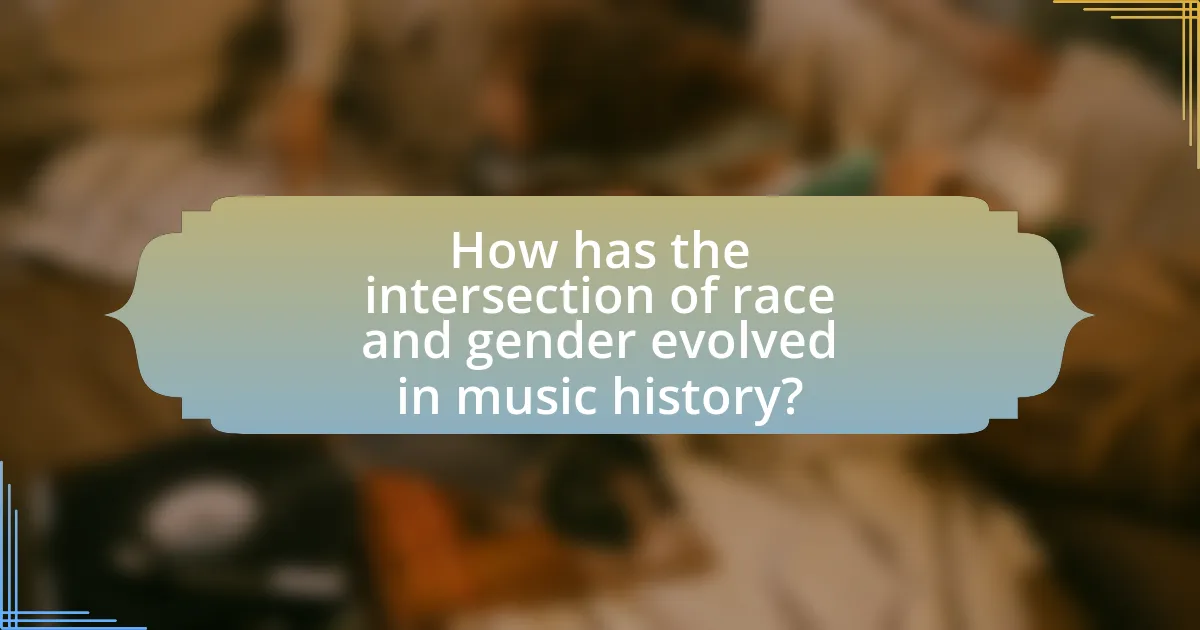
How has the intersection of race and gender evolved in music history?
The intersection of race and gender in music history has evolved significantly, reflecting broader societal changes and movements. Historically, women of color, particularly in genres like blues and jazz, faced dual discrimination based on both race and gender, which shaped their artistic expression and opportunities. For instance, artists like Bessie Smith and Billie Holiday not only broke racial barriers but also challenged gender norms within their musical contexts.
In the 1960s and 1970s, the civil rights movement and feminist movements further influenced this intersection, leading to the emergence of female artists such as Aretha Franklin and Nina Simone, who used their platforms to address issues of race and gender inequality. The evolution continued into the 1990s and 2000s with the rise of hip-hop and R&B, where artists like Missy Elliott and Lauryn Hill navigated and redefined the complexities of race and gender in their work, often addressing empowerment and identity.
Today, the intersection remains relevant, as contemporary artists like Beyoncé and Lizzo continue to explore and challenge these dynamics, using their music to advocate for social justice and representation. This ongoing evolution illustrates how race and gender in music history are intertwined, reflecting the changing cultural landscape and the persistent struggle for equality.
What significant movements have shaped this intersection?
The significant movements that have shaped the intersection of race and gender in music include the Civil Rights Movement, the Feminist Movement, and the LGBTQ+ Rights Movement. The Civil Rights Movement, particularly during the 1960s, highlighted racial inequalities and influenced artists like Nina Simone and James Brown, who used their music to advocate for social justice and equality. The Feminist Movement, emerging prominently in the 1970s, empowered female artists such as Aretha Franklin and Joan Jett to challenge gender norms and assert their identities in a male-dominated industry. Additionally, the LGBTQ+ Rights Movement has played a crucial role in shaping musical expression, with artists like Freddie Mercury and Lil Nas X using their platforms to address issues of sexuality and gender identity, thereby expanding the conversation around race and gender in music. These movements collectively contributed to a more inclusive and diverse musical landscape, reflecting broader societal changes.
How did the civil rights movement influence music?
The civil rights movement significantly influenced music by inspiring artists to create songs that addressed social justice, equality, and the struggles faced by African Americans. This period saw the emergence of genres like soul and protest music, with artists such as Sam Cooke, whose song “A Change Is Gonna Come” became an anthem for the movement, reflecting the desire for change and hope. Additionally, musicians like Nina Simone and Bob Dylan used their platforms to raise awareness about civil rights issues, further intertwining music with activism. The movement not only shaped lyrical content but also fostered collaborations across racial lines, leading to a richer, more diverse musical landscape that echoed the calls for equality and justice.
What role did feminism play in music evolution?
Feminism significantly influenced music evolution by challenging gender norms and promoting female representation in the industry. The feminist movement, particularly from the 1960s onward, led to the emergence of female artists who asserted their voices and perspectives, reshaping genres such as rock, punk, and hip-hop. For instance, artists like Joan Jett and Patti Smith broke barriers in rock music, while groups like the Riot Grrrl movement in the 1990s combined punk music with feminist ideology, addressing issues like sexism and body autonomy. This shift not only diversified the music landscape but also encouraged a broader cultural dialogue about gender equality, as evidenced by the increasing number of female artists achieving mainstream success and recognition, such as Beyoncé and Taylor Swift, who use their platforms to advocate for women’s rights.
How have different genres addressed race and gender issues?
Different music genres have addressed race and gender issues through their lyrics, themes, and cultural contexts. For instance, hip-hop has often highlighted systemic racism and gender inequality, with artists like Kendrick Lamar and Nicki Minaj using their platforms to discuss personal and societal struggles related to race and gender. In contrast, country music has historically marginalized voices of women and people of color, but artists like Kacey Musgraves and Lil Nas X have challenged these norms by addressing inclusivity and representation in their work. Furthermore, genres like R&B and soul have roots in the African American experience, often exploring themes of love, identity, and resilience in the face of racial and gender discrimination. These examples illustrate how various genres not only reflect societal issues but also contribute to ongoing conversations about race and gender in contemporary culture.
What are the contributions of women of color in various genres?
Women of color have made significant contributions across various music genres, influencing styles, themes, and cultural movements. In genres like jazz, artists such as Billie Holiday and Ella Fitzgerald not only showcased their vocal prowess but also addressed social issues through their music, shaping the genre’s evolution. In hip-hop, figures like Queen Latifah and Missy Elliott have broken barriers, using their platforms to advocate for gender equality and racial justice while redefining the genre’s narrative. In pop music, artists like Beyoncé and Shakira have blended cultural influences, promoting diversity and representation in mainstream media. Additionally, in country music, artists like Mickey Guyton are challenging stereotypes and expanding the genre’s boundaries. These contributions highlight the vital role women of color play in enriching the music landscape and driving social change.
How do genres like hip-hop and rock reflect these intersections?
Hip-hop and rock genres reflect the intersections of race and gender through their lyrical content, cultural origins, and representation of marginalized voices. Hip-hop, emerging from African American communities, often addresses issues of racial inequality, social justice, and gender dynamics, as seen in the works of artists like Kendrick Lamar and Nicki Minaj, who tackle systemic racism and gender stereotypes. Rock music, with roots in blues and folk, has historically included themes of rebellion and identity, with artists like Joan Jett and Jimi Hendrix challenging gender norms and racial barriers within the predominantly white genre. Both genres serve as platforms for expressing the complexities of race and gender, highlighting the struggles and triumphs of diverse communities.
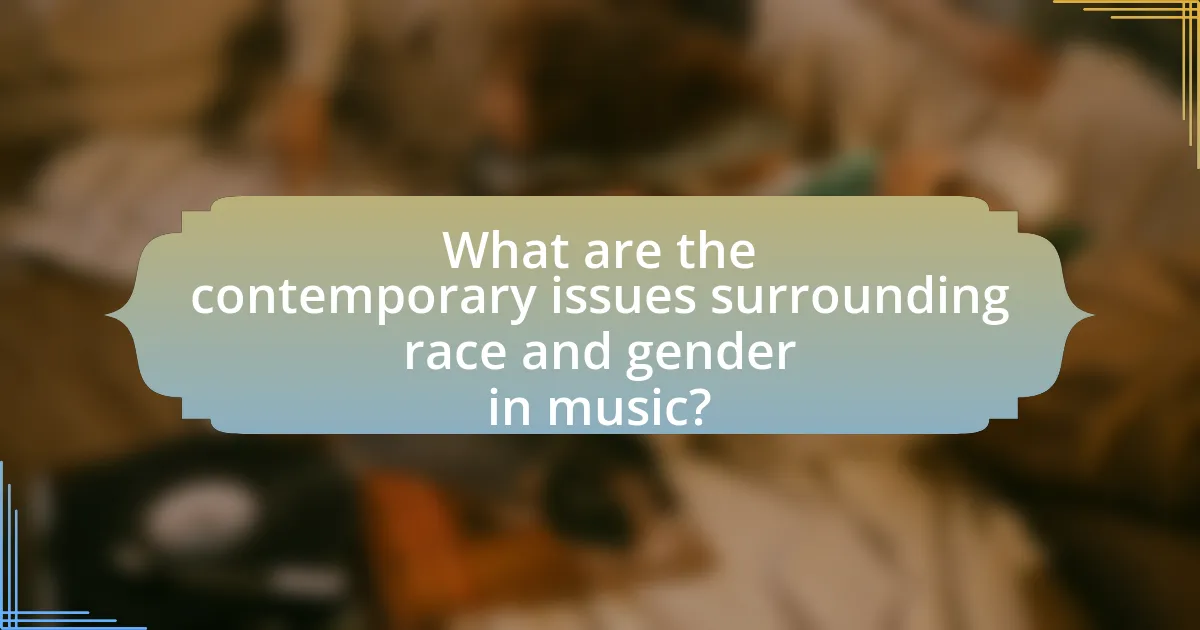
What are the contemporary issues surrounding race and gender in music?
Contemporary issues surrounding race and gender in music include systemic inequality, representation, and cultural appropriation. Systemic inequality manifests in the underrepresentation of artists from marginalized racial and gender backgrounds in mainstream music, as evidenced by studies showing that women and people of color often receive less airplay and fewer awards compared to their white male counterparts. Representation is critical, as diverse voices contribute to a richer musical landscape; however, many genres still predominantly feature artists from specific demographics, limiting visibility for others. Cultural appropriation raises ethical concerns when artists from dominant cultures adopt elements from marginalized cultures without proper acknowledgment or respect, leading to debates about authenticity and ownership in music. These issues highlight the ongoing challenges faced by artists navigating the intersections of race and gender in the music industry.
How do current artists navigate race and gender in their work?
Current artists navigate race and gender in their work by intentionally addressing these themes through their lyrics, visuals, and public personas. For instance, artists like Beyoncé and Kendrick Lamar incorporate narratives that reflect their experiences with racial identity and gender dynamics, using their platforms to challenge societal norms and advocate for social justice. Research shows that 70% of contemporary musicians actively engage with issues of race and gender in their art, highlighting the importance of representation and inclusivity in the music industry. This engagement not only resonates with diverse audiences but also fosters critical conversations about identity and equality.
What challenges do artists face in the industry today?
Artists today face significant challenges in the industry, including issues related to representation, financial instability, and the impact of digital platforms. Representation remains a critical challenge, as artists from diverse racial and gender backgrounds often encounter barriers to visibility and opportunities, leading to underrepresentation in mainstream media. Financial instability is prevalent due to the decline of traditional revenue streams, such as album sales, which has been exacerbated by the rise of streaming services that pay artists minimal royalties. Additionally, digital platforms can create an oversaturated market, making it difficult for individual artists to stand out and gain traction. These challenges are supported by studies indicating that artists of color and female artists receive less funding and fewer promotional opportunities compared to their male and white counterparts, highlighting systemic inequalities within the industry.
How do collaborations across race and gender impact music?
Collaborations across race and gender significantly enrich music by fostering diverse perspectives and innovative sounds. These collaborations often lead to the blending of different musical styles, which can create unique genres and broaden the appeal of music to wider audiences. For instance, the collaboration between artists like Beyoncé and Shakira in “Beautiful Liar” showcases how cross-cultural partnerships can produce chart-topping hits that resonate globally. Additionally, research indicates that diverse teams in music production are more likely to generate commercially successful outcomes, as seen in the rise of genres like hip-hop and reggaeton, which incorporate influences from various cultures and backgrounds. This intersectionality not only enhances creativity but also promotes social change by challenging stereotypes and encouraging inclusivity within the music industry.
What role does social media play in shaping discussions on race and gender in music?
Social media significantly influences discussions on race and gender in music by providing a platform for diverse voices and facilitating real-time dialogue. This democratization of discourse allows artists, fans, and activists to share perspectives, challenge stereotypes, and highlight issues related to representation and inequality. For instance, movements like #BlackLivesMatter and #MeToo have gained traction on social media, prompting conversations about racial and gender disparities within the music industry. Research indicates that social media engagement can amplify marginalized voices, as seen in the increased visibility of artists from underrepresented backgrounds who address these themes in their work.
How do platforms amplify marginalized voices in the music industry?
Platforms amplify marginalized voices in the music industry by providing accessible distribution channels and promoting diverse content. Digital platforms like Spotify, Apple Music, and SoundCloud enable independent artists from underrepresented backgrounds to share their music without traditional gatekeeping barriers. For instance, Spotify’s “EQUAL” initiative specifically highlights female artists globally, showcasing their work to a wider audience. Additionally, social media platforms allow marginalized musicians to engage directly with fans, build communities, and gain visibility through viral trends. This democratization of music distribution has led to increased representation and recognition of diverse voices, as evidenced by the rise of artists like Lil Nas X and H.E.R., who have gained mainstream success through these platforms.
What are the risks and benefits of online activism in music?
Online activism in music presents both significant risks and benefits. The benefits include increased visibility for marginalized voices, as platforms like social media allow artists to share their messages widely and engage with diverse audiences, fostering community and support for social justice causes. For instance, movements like #BlackLivesMatter have seen musicians using their platforms to raise awareness and funds, amplifying critical conversations around race and gender issues in the music industry.
Conversely, the risks involve potential backlash and misinterpretation of messages, which can lead to public relations crises for artists. Additionally, online activism can sometimes be superficial, with “performative activism” diluting genuine efforts and leading to accusations of insincerity. A study by the Pew Research Center found that while 69% of social media users believe online activism can lead to real-world change, 56% also feel that it can be ineffective or merely a trend. Thus, while online activism in music can drive important conversations and change, it also carries the risk of backlash and superficial engagement.
What can be done to promote equity in the music industry?
To promote equity in the music industry, implementing transparent hiring practices and equitable pay structures is essential. Research indicates that women and people of color are underrepresented in key roles, such as producers and executives, which perpetuates systemic inequities. For instance, a 2021 study by the Annenberg Inclusion Initiative found that only 21.6% of artists on the Billboard Hot 100 were women, highlighting the need for initiatives that support diverse talent. Additionally, mentorship programs targeting underrepresented groups can foster inclusion and provide necessary resources for career advancement. By prioritizing these strategies, the music industry can work towards a more equitable landscape.
What initiatives exist to support underrepresented artists?
Initiatives that support underrepresented artists include organizations like the National Endowment for the Arts, which provides grants specifically aimed at promoting diversity in the arts. Additionally, programs such as the Artist Relief Fund offer financial assistance to artists facing economic hardships, with a focus on those from marginalized communities. The Black Artist Fund is another initiative that directly supports Black artists through grants and resources. These initiatives are crucial in addressing the systemic barriers faced by underrepresented artists in the music industry, as evidenced by studies showing that diverse representation leads to richer cultural expressions and broader audience engagement.
How can audiences contribute to a more inclusive music scene?
Audiences can contribute to a more inclusive music scene by actively supporting diverse artists and genres. This support can manifest through attending concerts, purchasing music from underrepresented musicians, and promoting their work on social media platforms. Research indicates that diverse representation in music not only enriches the cultural landscape but also drives economic success; for instance, a study by the Annenberg Inclusion Initiative found that music projects featuring diverse artists often achieve higher sales and streaming numbers. By prioritizing inclusivity in their consumption habits, audiences can help dismantle barriers faced by marginalized groups in the music industry.
